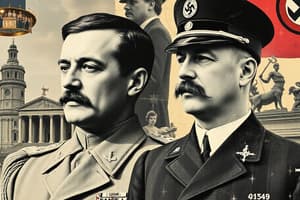Podcast
Questions and Answers
Kaiser Wilhelm II's foreign policy can be best described as:
Kaiser Wilhelm II's foreign policy can be best described as:
- Aggressive and expansionist, aiming to establish Germany as a dominant force. (correct)
- Supportive of international organizations and cooperative diplomacy.
- Cautious and diplomatic, focusing on maintaining peace through alliances.
- Isolationist, prioritizing domestic issues over international involvement.
Which of the following was NOT a significant challenge faced by the Weimar Republic?
Which of the following was NOT a significant challenge faced by the Weimar Republic?
- Political instability due to clashes between Communists and right-wing groups.
- Hyperinflation that rendered the currency nearly worthless.
- The burden of war reparations imposed by the Treaty of Versailles.
- Widespread public support for the democratic system. (correct)
How did the Nazis capitalize on the Great Depression to gain political power?
How did the Nazis capitalize on the Great Depression to gain political power?
- By forming coalitions with established political parties to stabilize the government.
- By advocating for strict adherence to the Treaty of Versailles.
- By ignoring the economic crisis and focusing on cultural programs.
- By promising economic recovery, jobs, and a restoration of national pride. (correct)
Which of the following best describes the role of propaganda in Nazi Germany?
Which of the following best describes the role of propaganda in Nazi Germany?
What was the primary goal of the Hitler Youth?
What was the primary goal of the Hitler Youth?
Which event symbolized Germany's division during the Cold War?
Which event symbolized Germany's division during the Cold War?
How did the Treaty of Versailles impact the Weimar Republic?
How did the Treaty of Versailles impact the Weimar Republic?
Why did Kaiser Wilhelm fire Bismarck?
Why did Kaiser Wilhelm fire Bismarck?
Which of the following groups were NOT persecuted by the Nazis?
Which of the following groups were NOT persecuted by the Nazis?
What role did Joseph Goebbels play in Nazi Germany?
What role did Joseph Goebbels play in Nazi Germany?
Which event marked the end of Nazi Germany?
Which event marked the end of Nazi Germany?
What event is most closely associated with Germany's reunification?
What event is most closely associated with Germany's reunification?
What was the immediate trigger for World War I?
What was the immediate trigger for World War I?
What political strategy did Hitler employ to become Chancellor of Germany in 1933?
What political strategy did Hitler employ to become Chancellor of Germany in 1933?
What was the purpose of the Berlin Wall?
What was the purpose of the Berlin Wall?
Flashcards
Kaiser Wilhelm II
Kaiser Wilhelm II
German Emperor (1890-1918) known for his aggressive foreign policy and desire for Germany to dominate Europe.
Weimar Republic
Weimar Republic
The democratic government of Germany between World War I and the rise of Nazism (1919-1933), marked by economic struggles and political instability.
Treaty of Versailles
Treaty of Versailles
An agreement that blamed Germany for WWI and required it to pay substantial reparations, causing economic hardship and resentment.
Hyperinflation
Hyperinflation
Signup and view all the flashcards
Rise of the Nazis
Rise of the Nazis
Signup and view all the flashcards
Reichstag
Reichstag
Signup and view all the flashcards
Nazi Germany
Nazi Germany
Signup and view all the flashcards
Gestapo
Gestapo
Signup and view all the flashcards
Persecution (Nazi Germany)
Persecution (Nazi Germany)
Signup and view all the flashcards
World War II
World War II
Signup and view all the flashcards
Divided Germany
Divided Germany
Signup and view all the flashcards
Berlin Wall
Berlin Wall
Signup and view all the flashcards
Cold War
Cold War
Signup and view all the flashcards
German Reunification
German Reunification
Signup and view all the flashcards
Study Notes
- Germany's history involves drama, power struggles, and redemption
Kaiser Wilhelm II (1890-1918)
- Kaiser Wilhelm II wanted Germany to be the most important country in Europe
- He dismissed Bismarck and started conflicts, leading to World War I
- After Germany's defeat in 1918, Wilhelm abdicated and fled to the Netherlands
Weimar Republic (1919-1933)
- The Weimar Republic was Germany's attempt at democracy after Wilhelm
- Germany was blamed for WWI and had to pay reparations due to the Treaty of Versailles
- Hyperinflation made money worthless
- Political conflict between communists and right-wingers weakened the government
- The Great Depression in 1929 caused people to lose faith, allowing the Nazis to gain influence
Rise of the Nazis (1929-1933)
- Hitler and the Nazis promised jobs, food, and to restore Germany's greatness during the Great Depression
- Hitler used propaganda effectively through posters, speeches, and rallies
- The Nazis became the largest party in the Reichstag by 1932
- In 1933, Hitler became Chancellor through a deal with President Hindenburg
Nazi Germany (1933-1945)
- Hitler established a dictatorship
- The SS and Gestapo used terror to enforce obedience
- Joseph Goebbels spread Nazi propaganda promoting "Heil Hitler" and "Aryan supremacy"
- Children were indoctrinated through the Hitler Youth
- Jews, LGBTQ+ people, disabled people and others were persecuted
- Hitler's pursuit of power led to World War II, resulting in Germany's destruction by 1945
Aftermath: Germany's Redemption Arc
- After WWII, Germany was divided into Communist East and Democratic West Germany
- East Germany built the Berlin Wall to prevent people from escaping to the West
- Germany was a central point of the Cold War between the USA and USSR
- In 1989, the Berlin Wall fell, leading to Germany's reunification
Studying That Suits You
Use AI to generate personalized quizzes and flashcards to suit your learning preferences.




